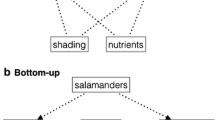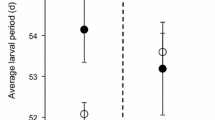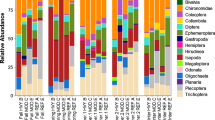Abstract
Predicting the ecological consequences of declining biodiversity is an urgent challenge, particularly in freshwater habitats where species declines and losses are among the highest. Small-scale experiments suggest potential ecosystem responses to losses of species, but definitive conclusions require verification at larger scales. We measured ecosystem metabolism and used whole-ecosystem stable isotope tracer additions to quantify nitrogen cycling in a tropical headwater stream before and after the sudden loss of amphibians to the fungal pathogen Batrachochytrium dendrobatidis. Tadpoles are normally dominant grazers in such streams, where greater than 18 species may co-occur and densities often exceed 50 individuals m−2. Loss of 98% of tadpole biomass corresponded with greater than 2× increases in algae and fine detritus biomass in the stream and a greater than 50% reduction in nitrogen uptake rate. Nitrogen turnover rates in suspended and deposited organic sediments were also significantly lower after the decline. As a consequence, the stream cycled nitrogen less rapidly, and downstream exports of particulate N were reduced. Whole stream respiration was significantly lower following the decline, indicating less biological activity in the stream sediments. Contrary to our predictions, biomass of grazing invertebrates, or any invertebrate functional groups, did not increase over 2 years following loss of tadpoles. Thus, reductions in ecosystem processes linked to the amphibian decline were not compensated for by other, functionally redundant consumers. Declining animal biodiversity has ecosystem-level consequences that may not be offset by ecological redundancy, even in biologically diverse regions such as the Neotropics.



Similar content being viewed by others
References
Barnosky AD, Koch PL, Feranec RS, Wing SL, Shabel AB. 2004. Assessing the causes of Late Pleistocene extinctions on the continents. Science 306:70–5.
Barnosky AD, Matzke N, Tomiya S, Wogan GOU, Swartz B, Quental TB, Marshall C, McGuire JL, Lindsey EL, Maguire KC, Mersey B, Ferrer EA. 2011. Has the Earth/’s sixth mass extinction already arrived? Nature 471:51–7.
Becker CG, Zamudio KR. 2011. Tropical amphibian populations experience higher disease risk in natural habitats. Proceedings of the National Academy of Sciences of the United States of America 108:9893–8.
Benke AC, Huryn AD, Smock LA, Wallace JB. 1999. Length-mass relationships for freshwater macroinvertebrates in North America with particular reference to the southeastern United States. Journal of the North American Benthological Society 18:308–43.
Bott TL. 2006. Primary productivity and community respiration. In: Hauer FR, Lamberti GA, Eds. Methods in stream ecology. Amsterdam: Elsevier. p 663–90.
Butchart SHM, Walpole M, Collen B, van Strien A, Scharlemann JPW, Almond REA, Baillie JEM, Bomhard B, Brown C, Bruno J, Carpenter KE, Carr GM, Chanson J, Chenery AM, Csirke J, Davidson NC, Dentener F, Foster M, Galli A, Galloway JN, Genovesi P, Gregory RD, Hockings M, Kapos V, Lamarque JF, Leverington F, Loh J, McGeoch MA, McRae L, Minasyan A, Morcillo MH, Oldfield TEE, Pauly D, Quader S, Revenga C, Sauer JR, Skolnik B, Spear D, Stanwell-Smith D, Stuart SN, Symes A, Tierney M, Tyrrell TD, Vie JC, Watson R. 2010. Global biodiversity: indicators of recent declines. Science 328:1164–8.
Cardinale BJ, Srivastava DS, Duffy JE, Wright JP, Downing AL, Sankaran M, Jouseau C. 2006. Effects of biodiversity on the functioning of trophic groups and ecosystems. Nature 443:989–92.
Carpenter SR, Cole JJ, Hodgson JR, Kitchell JF, Pace ML, Bade D, Cottingham KL, Essington TE, Houser JN, Schindler DE. 2001. Trophic cascades, nutrients, and lake productivity: whole-lake experiments. Ecological Monographs 71:163–86.
Colón-Gaud, C. 2008. Energy flow and macroinvertebrate production in Panamanian highland streams: assessing the impacts of amphibian declines. Department of Zoology. Southern Illinois University, Carbondale, IL.
Colón-Gaud C, Whiles MR, Brenes R, Kilham SS, Lips KR, Pringle CM, Connelly S, Peterson SD. 2010. Potential functional redundancy and resource facilitation between tadpoles and insect grazers. Freshwater Biology 55:2077–88.
Colón-Gaud C, Whiles MR, Kilham SS, Lips KR, Pringle CM, Connelly S, Peterson SD. 2009. Assessing ecological responses to catastrophic amphibian declines: patterns of macroinvertebrate production and food web structure in upland Panamanian streams. Limnology and Oceanography 54:331–43.
Connelly S, Pringle CM, Bixby RJ, Brenes R, Whiles MR, Lips KR, Kilham S, Huryn AD. 2008. Changes in stream primary producer communities resulting from large-scale catastrophic amphibian declines: can small-scale experiments predict effects of tadpole loss? Ecosystems 11:1262–76.
Crawford AJ, Lips KR, Bermingham E. 2010. Epidemic disease decimates amphibian abundance, species diversity, and evolutionary history in the highlands of central Panama. Proceedings of the National Academy of Sciences of the United States of America 107:13777–82.
Crowl TA, Crist TO, Parmenter RR, Belovsky G, Lugo AE. 2008. The spread of invasive species and infectious disease as drivers of ecosystem change. Frontiers in Ecology and the Environment 6:238–46.
Daszak P, Cunningham AA, Hyatt AD. 2000. Wildlife ecology: emerging infectious diseases of wildlife: threats to biodiversity and human health. Science 287:443–9.
Dodds WK, Evans-White MA, Gerlanc NM, Gray L, Gudder DA, Kemp MJ, Lopez AL, Stagliano D, Strauss EA, Tank JL, Whiles MR, Wollheim WM. 2000. Quantification of the nitrogen cycle in a prairie stream. Ecosystems 3:574–89.
Duffy JE. 2009. Why biodiversity is important to the functioning of real-world ecosystems. Frontiers in Ecology and the Environment 7:437–44.
Estes JA, Terborgh J, Brashares JS, Power ME, Berger J, Bond WJ, Carpenter SR, Essington TE, Holt RD, Jackson JBC, Marquis RJ, Oksanen L, Oksanen T, Paine RT, Pikitch EK, Ripple WJ, Sandin SA, Scheffer M, Schoener TW, Shurin JB, Sinclair ARE, Soule ME, Virtanen R, Wardle DA. 2011. Trophic downgrading of planet earth. Science 333:301–6.
Flecker AS, Feifarek BP, Taylor BW. 1999. Ecosystem engineering by a tropical tadpole: density-dependent effects on habitat structure and larval growth rates. Copeia 2:495–500.
Greathouse EA, Pringle CM, McDowell WH, Holmquist JG. 2006. Indirect upstream effects of dams: consequences of migratory consumer extirpation in Puerto Rico. Ecological Applications 16:339–52.
Hall RO, Baker MA, Arp CD, Koch BJ. 2009. Hydrologic control of nitrogen removal, storage, and export in a mountain stream. Limnology and Oceanography 54:2128–42.
Hall RO, Peterson BJ, Meyer JL. 1998. Testing a nitrogen-cycling model of a forest stream by using a nitrogen-15 tracer addition. Ecosystems 1:283–98.
Hall RO, Taylor BW, Flecker AS. 2011. Detritivorous fish indirectly reduce insect secondary production in a tropical river. Ecosphere 2:135. doi:10.1890/ES11-00042.1.
Hebblewhite M, White CA, Nietvelt CG, McKenzie JA, Hurd TE, Fryxell JM, Bayley SE, Paquet PC. 2005. Human activity mediates a trophic cascade caused by wolves. Ecology 86:2135–44.
Hooper DU, Chapin FS, Ewel JJ, Hector A, Inchausti P, Lavorel S, Lawton JH, Lodge DM, Loreau M, Naeem S, Schmid B, Setala H, Symstad AJ, Vandermeer J, Wardle DA. 2005. Effects of biodiversity on ecosystem functioning: a consensus of current knowledge. Ecological Monographs 75:3–35.
Jassby AD, Platt T. 1976. Mathematical formulation of the relationship between photosynthesis and light for phytoplankton. Limnology and Oceanography 21:540–7.
Jenkins M. 2003. Prospects for biodiversity. Science 302:1175–77.
Kohler SL, Wiley MJ. 1997. Pathogen outbreaks reveal large-scale effects of competition in stream communities. Ecology 78:2164–76.
Laws E. 1984. Isotope dilution modeled and the mystery of the vanishing 15 N. Limnology and Oceanography 29:379–86.
Lips KR, Brem F, Brenes R, Reeve JD, Alford RA, Voyles J, Carey C, Livo L, Pessier AP, Collins JP. 2006. Emerging infectious disease and the loss of biodiversity in a Neotropical amphibian community. Proceedings of the National Academy of Sciences of the United States of America 103:3165–70.
Loeb SL. 1981. An in situ method for measuring the primary productivity and standing crop of the epilithic periphyton community in lentic systems. Limnology and Oceanography 26:394–9.
Loreau M. 2010. Linking biodiversity and ecosystems: towards a unifying ecological theory. Philosophical Transactions of the Royal Society B-Biological Sciences 365:49–60.
McIntyre PB, Flecker AS, Vanni MJ, Hood JM, Taylor BW, Thomas SA. 2008. Fish distributions and nutrient cycling in streams: can fish create biogeochemical hotspots? Ecology 89:2335–46.
Merritt RW, Cummins KW, Berg MB, Eds. 2008. An introduction to the aquatic insects of North America. Dubuque: Kendall/Hunt Publishing Company.
Mulholland PJ, Hall RO, Sobota DJ, Dodds WK, Findlay SFOREXAMPLE, Grimm NB, Hamilton SK, McDowell WH, O’Brien JM, Tank JL, Ashkenas LR, Cooper LW, Dahm CN, Gregory SV, Johnson SL, Meyer JL, Peterson BJ, Poole GC, Valett HM, Webster JR, Arango CP, Beaulieu JJ, Bernot MJ, Burgin AJ, Crenshaw CL, Helton AM, Johnson LT, Niederlehner BR, Potter JD, Sheibley RW, Thomas SM. 2009. Nitrate removal in stream ecosystems measured by N-15 addition experiments: denitrification. Limnology and Oceanography 54:666–80.
Pauly D, Christensen V, Dalsgaard J, Froese R, Torres F. 1998. Fishing down marine food webs. Science 279:860–3.
Pearson RG, Boyero L. 2009. Gradients in regional diversity of freshwater taxa. Journal of the North American Benthological Society 28:504–14.
Petchey OL, Downing AL, Mittelbach GG, Persson L, Steiner CF, Warren PH, Woodward G. 2004. Species loss and the structure and functioning of multitrophic aquatic systems. Oikos 104:467–78.
Peterson BJ, Wollheim WM, Mulholland PJ, Webster JR, Meyer JL, Tank JL, Marti E, Bowden WB, Valett HM, Hershey AE, McDowell WH, Dodds WK, Hamilton SK, Gregory S, Morrall DD. 2001. Control of nitrogen export from watersheds by headwater streams. Science 292:86–90.
R Development Core Team. 2010. R: a language and environment for statistical computing. Vienna: R Foundation for Statistical Computing. ISBN 3-900051-07-0
Ranvestel AW, Lips KR, Pringle CM, Whiles MR, Bixby RJ. 2004. Neotropical tadpoles influence stream benthos: evidence for the ecological consequences of decline in amphibian populations. Freshwater Biology 49:274–85.
Solan M, Cardinale BJ, Downing AL, Engelhardt KAM, Ruesink JL, Srivastava DS. 2004. Extinction and ecosystem function in the marine benthos. Science 306:1177–80.
Swei A, Rowley JJL, Rodder D, Diesmos MLL, Diesmos AC, Briggs CJ, Brown R, Cao TT, Cheng TL, Chong RA, Han B, Hero JM, Hoang HD, Kusrini MD, Duong TTL, McGuire JA, Meegaskumbura M, Min MS, Mulcahy DG, Neang T, Phimmachak S, Rao DQ, Reeder NM, Schoville SD, Sivongxay N, Srei N, Stock M, Stuart BL, Torres LS, Dao TAT, Tunstall TS, Vieites D, Vredenburg VT. 2011. Is Chytridiomycosis an emerging infectious disease in Asia? Plos One 6(8):e23179. doi:10.1371/journal.pone.0023179.
Taylor BW, Flecker AS, Hall RO. 2006. Loss of a harvested fish species disrupts carbon flow in a diverse tropical river. Science 313:833–6.
Vaughn CC. 2010. Biodiversity losses and ecosystem function in freshwaters: emerging conclusions and research directions. Bioscience 60:25–35.
Wallace JB, Eggert SL, Meyer JL, Webster JR. 1997. Multiple trophic levels of a forest stream linked to terrestrial litter inputs. Science 277:102–4.
Wallace JB, Webster JR. 1996. The role of macroinvertebrates in stream ecosystem function. Annual Review of Entomology 41:115–39.
Wardle DA, Bardgett RD, Callaway RM, Van der Putten WH. 2011. Terrestrial ecosystem responses to species gains and losses. Science 332:1273–7.
Whiles MR, Huryn AD, Taylor BW, Reeve JD. 2009. Influence of handling stress and fasting on estimates of ammonium excretion by tadpoles and fish: recommendations for designing excretion experiments. Limnology and Oceanography-Methods 7:1–7.
Whiles MR, Lips KR, Pringle CM, Kilham SS, Bixby RJ, Brenes R, Connelly S, Colón-Gaud JC, Hunte-Brown M, Huryn AD, Montgomery C, Peterson S. 2006. The effects of amphibian population declines on the structure and function of Neotropical stream ecosystems. Frontiers in Ecology and the Environment 4:27–34.
Wollheim WM, Peterson BJ, Deegan LA, Bahr M, Hobbie JE, Jones D, Bowden WB, Hershey AE, Kling GW, Miller MC. 1999. A coupled field and modeling approach for the analysis of nitrogen cycling in streams. Journal of the North American Benthological Society 18:199–221.
Acknowledgments
This research was supported by National Science Foundation Grants DEB #0717741 and DEB #0645875. The Smithsonian Tropical Research Institute and Autoridad Nacional del Ambiente (ANAM) provided logistical support in Panamá. E. Rosi-Marshall, J. Tank, and J. E. Garvey provided constructive comments on the manuscript. E. Griffiths and H. Ross assisted with field sampling and provided taxonomic expertise. L. Barrow, D. Govoni, T. Frauendorf, and J. Uzzardo assisted with sample processing. All the research detailed in this manuscript complies with the current laws of the Republic of Panamá. Animal handling and sacrifices followed SIU animal care protocols (Protocol 06-008).
Author information
Authors and Affiliations
Corresponding author
Additional information
Author contributions
MRW, ROH, and WKD led development of the study design and manuscript and participated in field work. PV, ATR, SC, and ADH performed much of the field work. CC-G, SC, PV, and SP analyzed data. KRL, PV, CMP, SSK, and ADH designed components of the study and wrote portions of the manuscript.
Rights and permissions
About this article
Cite this article
Whiles, M.R., Hall, R.O., Dodds, W.K. et al. Disease-Driven Amphibian Declines Alter Ecosystem Processes in a Tropical Stream. Ecosystems 16, 146–157 (2013). https://doi.org/10.1007/s10021-012-9602-7
Received:
Accepted:
Published:
Issue Date:
DOI: https://doi.org/10.1007/s10021-012-9602-7




